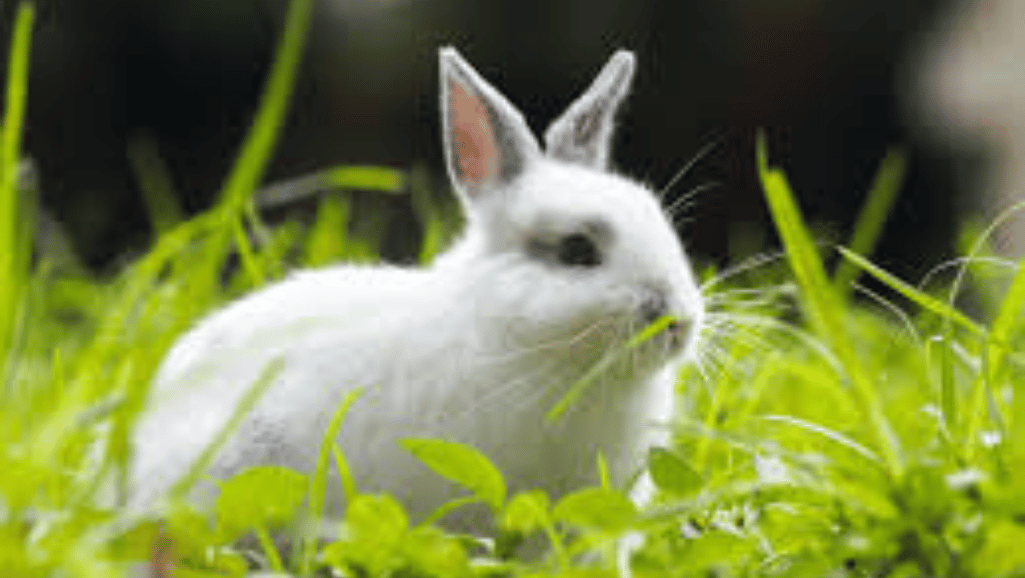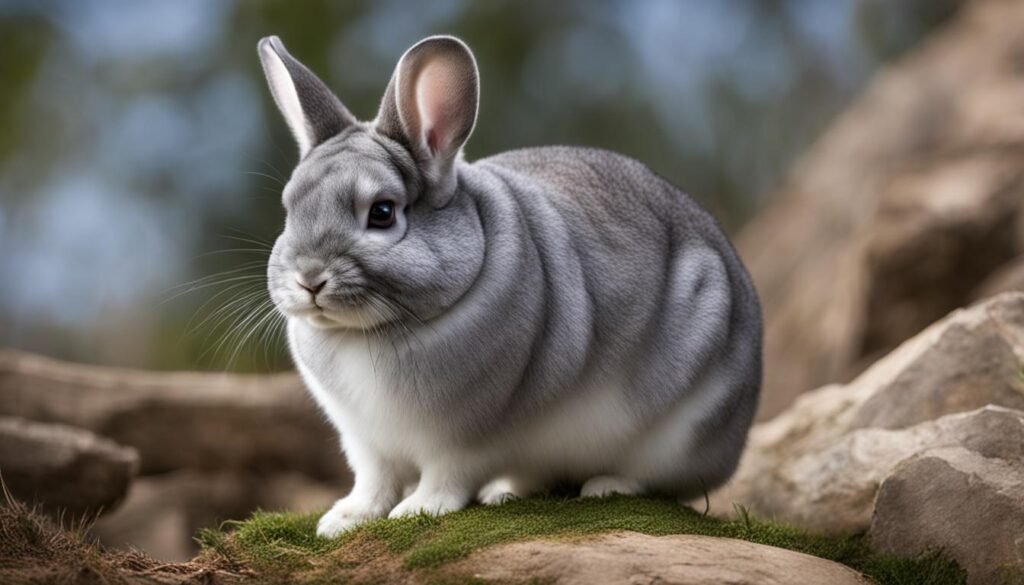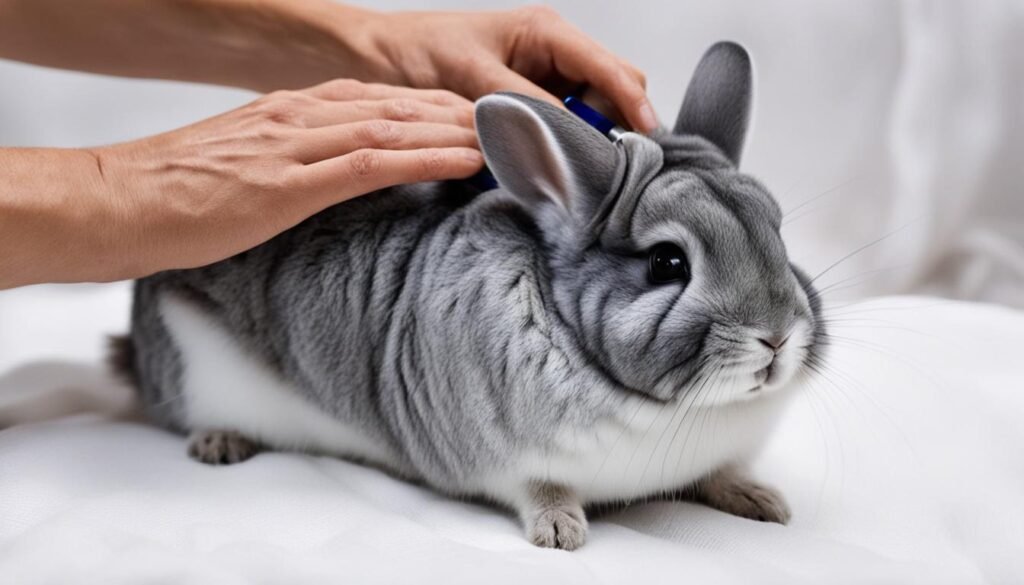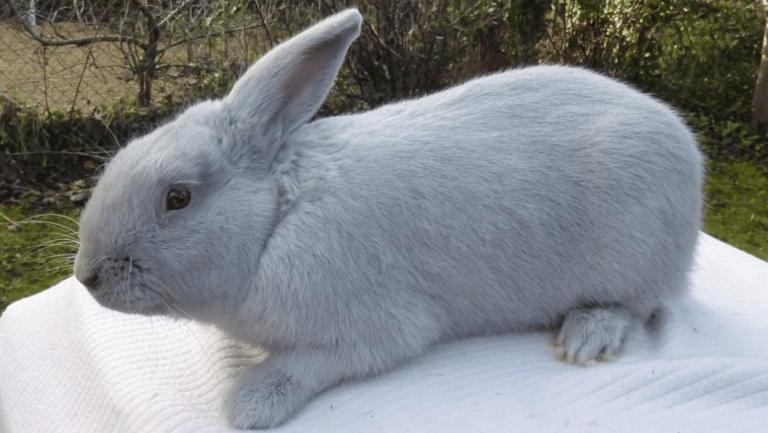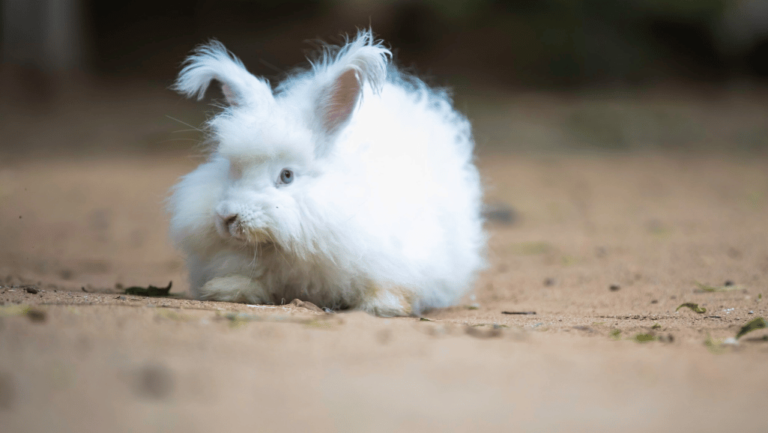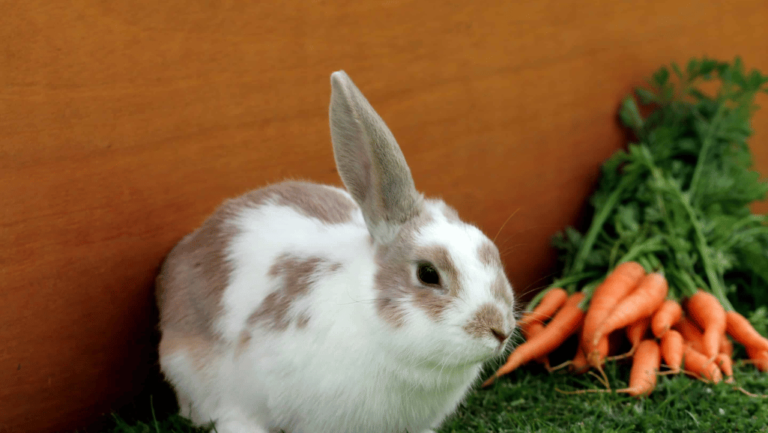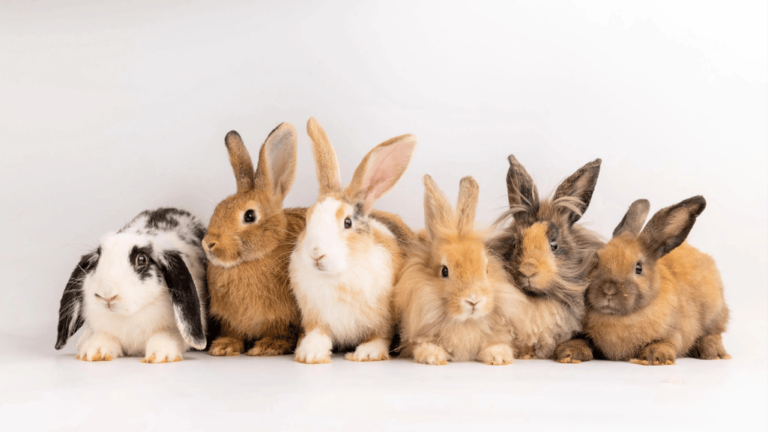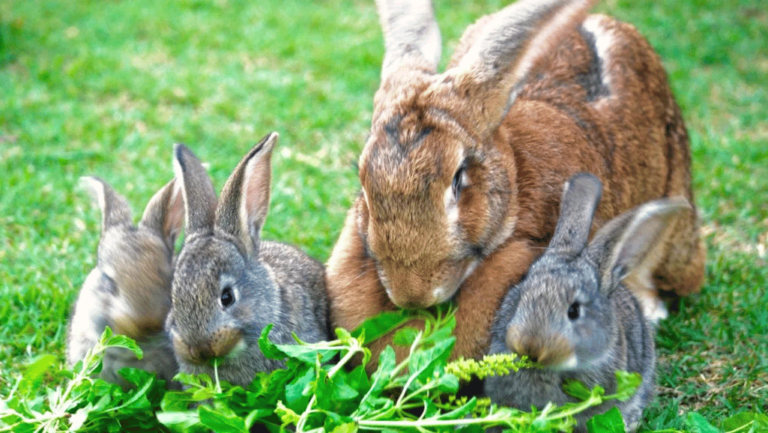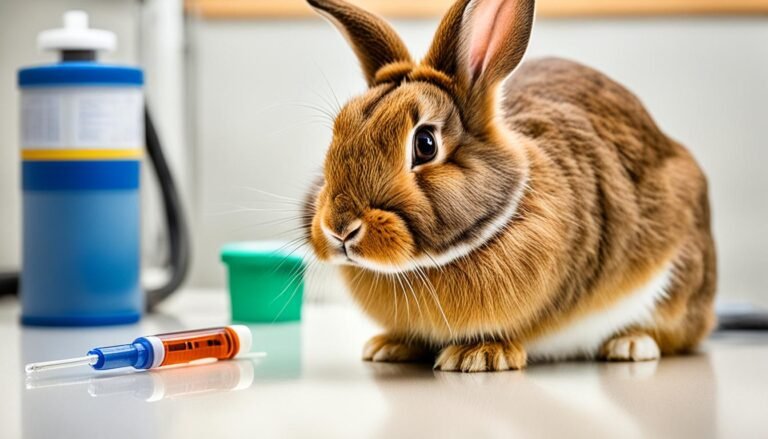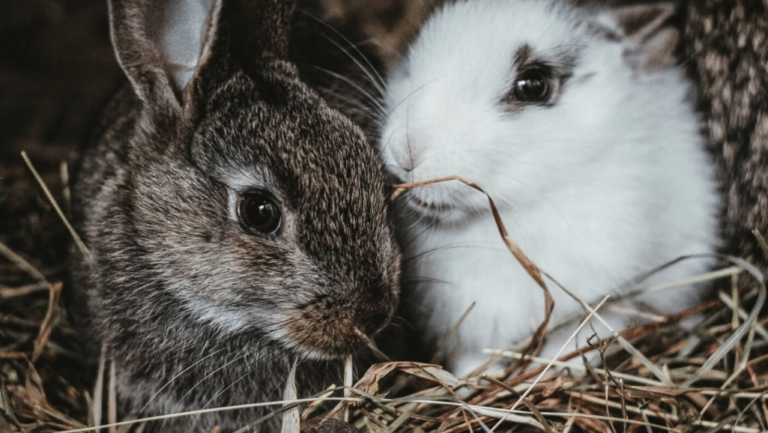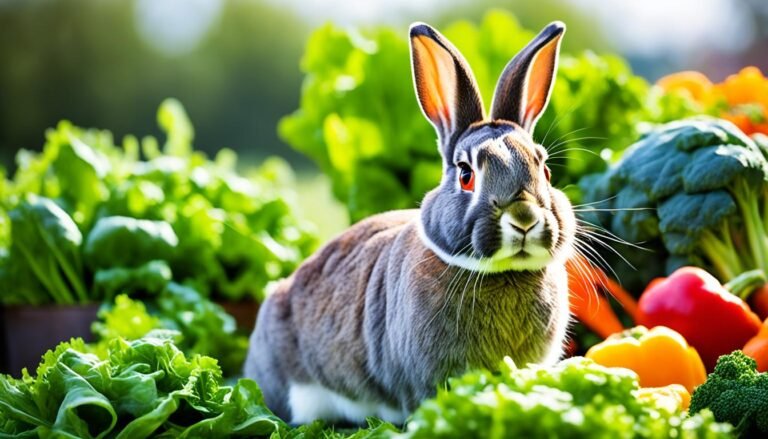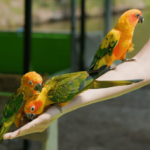Welcome to our article on American Chinchilla Rabbit breeds, a true heritage of the rabbit world. These rabbits have a fascinating history and are beloved by dedicated breeders. Let’s explore more about this American classic.
Key Takeaways:
- American Chinchilla Rabbits have a rich history and are known for their resemblance to the South American Chinchilla lanigera.
- Created by M.J. Dybowski in 1913, these rabbits gained popularity for their larger size for meat and pelts.
- They are hardy, large in size, and exhibit excellent mothering instincts.
- The breed’s coat is salt and pepper colored, with distinct color bands.
- Conservation efforts are essential to preserve this endangered breed and its important genetic resources.
History of the American Chinchilla Rabbit Breed
The American Chinchilla Rabbit breed has a rich history and has left a profound impact on the rabbit industry. Originally developed as a fur rabbit, it gained popularity in Europe for its remarkable resemblance to the South American Chinchilla. Breeders recognized the potential of the breed and dedicated their efforts to improving its size and meat-producing qualities.
In the early 20th century, the American Chinchilla Rabbit played a pivotal role in the rabbit fur industry. Its luxurious and beautifully patterned coat made it highly sought after. The breed’s fur was utilized for various purposes, such as hats, coats, and other fashion accessories.
The American Chinchilla Rabbit breed also contributed significantly to the development of other breeds and varieties worldwide. Its genetics were instrumental in the creation of breeds such as the Silver Martens, American Sables, Siamese Sables, and Sallander. As breeders aimed to enhance specific traits, the American Chinchilla Rabbit served as a foundational breed upon which these distinct varieties were built.
However, the decline of the rabbit fur industry in the late 1940s had an adverse impact on the American Chinchilla population. With the shift in fashion trends and the rise of synthetic materials, the demand for rabbit fur decreased significantly. Consequently, many breeders shifted their focus to other commercially viable breeds, leading to a decline in the American Chinchilla Rabbit breed.
Despite the challenges faced by the breed, the American Chinchilla Rabbit remains an essential part of rabbit breed history. Its impact on the industry and the development of other breeds cannot be overlooked. Efforts are being made to preserve and promote this remarkable breed, ensuring its place in the annals of rabbit history.
Characteristics of the American Chinchilla Rabbit
The American Chinchilla Rabbit is a remarkable breed known for its distinct characteristics. Let’s explore the size, weight, and coat color of this fascinating rabbit.
Size and Weight
The American Chinchilla Rabbit is considered a large breed. Mature bucks typically weigh between 9 to 11 pounds, while does range from 10 to 12 pounds. This size makes them visually impressive and adds to their appeal as livestock.
Coat Color
The coat of the American Chinchilla Rabbit is salt and pepper colored, giving it a unique and beautiful appearance. Interestingly, when the coat is blown into, four distinct bands of color become visible, enhancing the visual appeal of the breed.
Temperament and Reproduction
- Gentle temperament: The American Chinchilla Rabbit is known for its gentle and docile nature. This makes them suitable for families and individuals looking for a friendly and easy-to-handle pet.
- Large litters: This breed is highly prolific, producing large litters. This quality contributes to their value as meat producers and allows breeders to maintain a thriving population.
- Good mothering instincts: American Chinchilla Does exhibit exceptional mothering instincts, caring for their young with love and dedication.
Meat Production and Growth Rate
The American Chinchilla Rabbit is renowned for its fine meat-producing qualities. Their quick growth rate allows them to reach market weight in a shorter period compared to other rabbit breeds. This efficiency makes them a preferred choice for meat production.
| Characteristic | Details |
|---|---|
| Size | Large |
| Weight (Bucks) | 9 to 11 pounds |
| Weight (Does) | 10 to 12 pounds |
| Coat Color | Salt and pepper with distinct color bands when blown |
| Temperament | Gentle and docile |
| Reproduction | Large litters with good mothering instincts |
| Meat Production | High-quality meat with quick growth rate |
Endangered Status of the American Chinchilla Rabbit
The American Chinchilla Rabbit, a breed that holds a special place among Chinchilla breeds, is currently facing an endangered status. This breed, known for its unique characteristics and contributions to the rabbit fur industry and meat market, now finds itself struggling to maintain its population.
One of the factors contributing to the endangered status of the American Chinchilla Rabbit is the decline of the rabbit fur industry. Once highly sought after for its luxurious fur, the demand for rabbit fur has significantly decreased over time. As a result, fewer breeders are focusing on raising American Chinchilla Rabbits, leading to a decline in their numbers.
Another reason for their endangered status is the preference for all-white rabbits in the meat market. While the American Chinchilla Rabbit boasts fine meat producing qualities, it faces competition from other breeds that are more popular due to their white fur. This preference has caused a decline in the popularity and demand for American Chinchilla Rabbits in the meat market.
Despite these challenges, efforts are being made to preserve and protect this endangered breed. Organizations and dedicated breeders recognize the importance of maintaining the genetic diversity and heritage of the American Chinchilla Rabbit. Through education, promotion, and conservation initiatives, they strive to raise awareness about the breed and its significance in the rabbit breeding community.
Preserving the American Chinchilla Rabbit is crucial not only for the breed itself but also for the overall diversity and sustainability of rabbit breeds. This breed has a unique history and has contributed to the development of other breeds in the rabbit breeding world. By protecting and supporting the American Chinchilla Rabbit, we ensure that future generations can appreciate its beauty, characteristics, and the legacy it carries.
Impact of the American Chinchilla Rabbit on Other Breeds
The American Chinchilla Rabbit has played a crucial role in the development of various breeds within the rabbit breeding community. Its unique genetics and desirable characteristics have influenced the creation of several notable breeds both in the United States and abroad.
Silver Martens:
The American Chinchilla Rabbit contributed significantly to the development of the Silver Marten breed in the United States. By crossing American Chinchillas with other breeds, breeders achieved the distinctive silver-tipped fur that characterizes Silver Martens. Today, Silver Martens are recognized for their striking appearance and are highly sought after for their beautiful coats.
American Sables:
Another breed indebted to the American Chinchilla Rabbit is the American Sable. By selectively breeding American Chinchillas, breeders were able to produce the desirable sepia-brown coat color of American Sables. These rabbits are known for their lovely fur and friendly temperaments.
Siamese Sable and Sallander Breeds:
The influence of the American Chinchilla Rabbit extends beyond the United States. In other parts of the world, such as Europe, it has contributed to the creation of breeds like the Siamese Sable and Sallander. Through careful breeding and selection, breeders were able to develop rabbits with unique coat colors that mimic those of the American Chinchilla. These breeds have gained popularity for their distinctive appearances and are cherished by rabbit enthusiasts worldwide.
The American Chinchilla Rabbit’s significant impact on breed development is a testament to the breed’s enduring influence on the rabbit breeding community. Its genetics and characteristics continue to shape and inspire the creation of new and exciting breeds, ensuring a vibrant and diverse rabbit population.
Care and Maintenance of the American Chinchilla Rabbit
Proper care and maintenance are essential for keeping your American Chinchilla Rabbit happy and healthy. This breed requires regular grooming to maintain its beautiful coat and adhere to breed standards. Here are some guidelines to help you take care of your American Chinchilla Rabbit:
Rabbit Grooming
The American Chinchilla Rabbit’s coat is one of its distinctive features. To keep the coat in prime condition, regular grooming is necessary. This includes brushing the fur to remove tangles and debris and blowing out the coat to reveal the distinct color bands. Grooming not only keeps the coat looking its best, but it also promotes good blood circulation and prevents matting.
Rabbit Care
American Chinchilla Rabbits are generally low maintenance and hardy, but they still require proper care and attention. Here are some general care tips:
- Provide a spacious and comfortable living environment with appropriate bedding, hiding spots, and toys.
- Offer a balanced diet consisting of high-quality hay, fresh vegetables, and a limited amount of commercial rabbit pellets.
- Ensure access to clean water at all times.
- Keep their living area clean and provide regular spot cleaning and full cage cleaning as needed.
- Monitor their health regularly and seek veterinary care if any health issues arise.
Breed Standards
Breed standards are guidelines that set the ideal characteristics for the American Chinchilla Rabbit in terms of size, shape, and coat color. By adhering to these standards, breeders aim to preserve the breed’s unique qualities. Here are the breed standards for the American Chinchilla Rabbit:
| Characteristics | Ideal |
|---|---|
| Size (weight) | Bucks: 9-11 pounds Does: 10-12 pounds |
| Body Shape | Compact and well-muscled |
| Coat Color | Salt and pepper with four distinct color bands when blown into |
Adhering to these breed standards helps maintain the integrity and unique characteristics of the American Chinchilla Rabbit breed.
To sum up, taking care of an American Chinchilla Rabbit involves regular grooming to maintain its coat’s beauty, general rabbit care practices, and adhering to breed standards to preserve its unique qualities. By providing the necessary care and attention, you can ensure that your American Chinchilla Rabbit remains healthy and happy.
Popularity and Availability of the American Chinchilla Rabbit
The American Chinchilla Rabbit is a rare breed with a small population. Once highly sought after for its fur, the breed faced a decline in population as the demand for fur decreased. Despite efforts to preserve and promote the breed, it remains relatively uncommon compared to other rabbit breeds.
Today, the American Chinchilla Rabbit is considered a rare find among rabbit enthusiasts. Its unique characteristics and history make it an appealing choice for those looking for a special rabbit breed. However, due to its rarity, finding an American Chinchilla Rabbit may require more effort compared to more popular breeds.
Although the American Chinchilla Rabbit’s population is small, there are breeders and organizations dedicated to preserving and promoting this rare breed. These efforts aim to raise awareness about the American Chinchilla Rabbit and ensure its survival.
Availability of American Chinchilla Rabbit Compared to Other Rabbit Breeds
| Rabbit Breed | Availability |
|---|---|
| American Chinchilla Rabbit | Rare |
| Dutch Rabbit | Common |
| Lionhead Rabbit | Popular |
| Rex Rabbit | Widely available |
The table above compares the availability of the American Chinchilla Rabbit to other popular rabbit breeds. It highlights the rarity of the American Chinchilla Rabbit and the challenges in finding one.
While the American Chinchilla Rabbit may not be as readily available as other breeds, its unique qualities and limited population make it a prized possession for those lucky enough to have one.
American Chinchilla Rabbits as Pets
American Chinchilla Rabbits are not only a rare and unique breed, but they also make fantastic pets. Their gentle and docile temperament makes them well-suited for families and individuals alike. These rabbits enjoy human interaction and have the ability to form strong bonds with their owners, making them wonderful companions.
When considering an American Chinchilla Rabbit as a pet, potential owners should take into account their size and space requirements. These rabbits are larger in size, with mature bucks weighing 9 to 11 pounds and does weighing 10 to 12 pounds. It’s essential to provide them with enough space to move around and exercise comfortably. A spacious habitat, both indoors and outdoors, is ideal for them to thrive.
Rabbit companionship is essential for the well-being of these social animals. Consider providing your American Chinchilla Rabbit with a compatible rabbit companion to ensure they have a fulfilling social life. This can help prevent loneliness and provide them with a playmate and a source of mental stimulation.
Key Points to Consider
- American Chinchilla Rabbits have a gentle and docile temperament, making them suitable for families and individuals.
- They require adequate space to accommodate their larger size.
- Rabbit companionship is essential to fulfill their social needs.
Pros and Cons of Owning an American Chinchilla Rabbit
| Pros | Cons |
|---|---|
| Docile and gentle temperament | Requires ample space for exercise |
| Forms strong bonds with owners | Needs rabbit companionship for optimal socialization |
| Can be a great addition to families | May require additional grooming due to their distinct coat |
Rabbit Breeding and Conservation Efforts
The conservation of rare and endangered livestock and poultry breeds, including the American Chinchilla Rabbit, is a top priority for the Livestock Conservancy. This dedicated organization works tirelessly to raise awareness about endangered breeds and encourages breeders to take part in the preservation and protection of these valuable genetic resources.
Breed stewardship plays a crucial role in ensuring the survival and diversity of rabbit breeds like the American Chinchilla. By promoting responsible breeding practices and supporting breeders in their efforts, the Livestock Conservancy helps to maintain the population of endangered breeds and safeguard their unique characteristics.
Impact of Conservation Efforts on Endangered Rabbit Breeds
| Endangered Rabbit Breed | Conservation Efforts | Current Population Estimate |
|---|---|---|
| American Chinchilla Rabbit | Livestock Conservancy programs, breed awareness campaigns, collaboration with breeders | Approximately 500 breeding animals |
| Dutch Rabbit | Conservation breeding programs, education initiatives | Approximately 1,000 breeding animals |
| Blanc de Hotot Rabbit | Conservation breeding, research, outreach programs | Approximately 800 breeding animals |
The Livestock Conservancy’s work extends beyond conservation efforts alone. They also collaborate with breeders and provide valuable resources and guidance to ensure the long-term viability of endangered rabbit breeds. Through educational programs and support networks, they empower breeders to become dedicated stewards of these unique and valuable breeds.
Conclusion
The American Chinchilla Rabbit is a rare and unique breed that holds a special place in the world of rabbit breeding. With its rich history and significant contributions to the industry, it has become a favorite among breeders and enthusiasts alike. However, the breed currently faces challenges that threaten its survival.
The decline of the rabbit fur industry, coupled with the preference for all-white rabbits in the meat market, has led to a decline in the American Chinchilla Rabbit population. This endangered status highlights the importance of breed stewardship and conservation efforts to protect the genetic diversity and heritage of this remarkable breed.
To preserve the American Chinchilla Rabbit and other heritage breeds, organizations like the Livestock Conservancy play a crucial role in raising awareness and promoting responsible breeding practices. It is through these collective efforts that we can ensure the continued existence of this rare breed and maintain the diversity and charm it brings to the rabbit breeding community.
Frequently Asked Questions
What is the history of the American Chinchilla Rabbit breed?
The American Chinchilla Rabbit breed was created by a French engineer named M.J. Dybowski in 1913. It gained popularity for its resemblance to the South American Chinchilla lanigera. The breed was first imported to England in 1917 and later to the United States in 1919. American breeders worked to develop a larger size for meat and pelts. The breed is known for its hardiness, large size, and good mothering instincts.
What are the characteristics of the American Chinchilla Rabbit?
The American Chinchilla Rabbit is a large breed, with mature bucks weighing 9 to 11 pounds and does weighing 10 to 12 pounds. They have a gentle temperament, produce large litters, and have good mothering instincts. Their coat is salt and pepper colored, but when blown into, four distinct bands of color appear. The breed is known for its fine meat-producing qualities and quick growth rate.
Is the American Chinchilla Rabbit an endangered breed?
Yes, the American Chinchilla Rabbit is considered a rare breed due to its small population. It was once highly sought after for its fur, but as the demand for fur declined, so did the population of the breed. Today, there are efforts to preserve and promote the breed, but it remains relatively uncommon compared to other rabbit breeds.
What impact has the American Chinchilla Rabbit had on other breeds?
The American Chinchilla Rabbit has had a significant impact on the development of other breeds. It has contributed to the creation of the Silver Martens and American Sables in the United States, as well as the Siamese Sable and Sallander breeds abroad. Its genetics and characteristics have been influential in the rabbit breeding community.
How should I care for and maintain an American Chinchilla Rabbit?
The American Chinchilla Rabbit requires regular grooming to maintain its coat. This includes brushing and blowing out the fur to reveal the distinct color bands. They are generally low maintenance and hardy rabbits but still require proper care and attention. Breed standards provide guidelines for their ideal size, shape, and coat color.
Is the American Chinchilla Rabbit a popular breed?
The American Chinchilla Rabbit is considered a rare breed due to its small population. It was once highly sought after for its fur, but as the demand for fur declined, so did the population of the breed. Today, there are efforts to preserve and promote the breed, but it remains relatively uncommon compared to other rabbit breeds.
Can the American Chinchilla Rabbit be kept as a pet?
American Chinchilla Rabbits can make wonderful pets. They have a gentle and docile temperament, making them suitable for families and individuals alike. They enjoy human interaction and can form strong bonds with their owners. However, potential rabbit owners should consider their size and space requirements before adopting an American Chinchilla Rabbit as a pet.
What efforts are being made for the conservation of the American Chinchilla Rabbit breed?
The Livestock Conservancy is an organization dedicated to the conservation of rare and endangered livestock and poultry breeds, including the American Chinchilla Rabbit. They work to raise awareness about endangered breeds and encourage breeders to preserve and protect these valuable genetic resources. Conservation efforts are essential to ensuring the survival and diversity of rabbit breeds like the American Chinchilla.
What makes the American Chinchilla Rabbit breed unique?
The American Chinchilla Rabbit is a rare and unique breed with a rich history and important contributions to the rabbit breeding world. Its heritage and charm make it a favorite among breeders and enthusiasts. However, the breed faces challenges due to the decline of the rabbit fur industry and the preference for all-white rabbits in the meat market. Conservation efforts are crucial to maintaining the genetic diversity and heritage of the American Chinchilla Rabbit breed.

